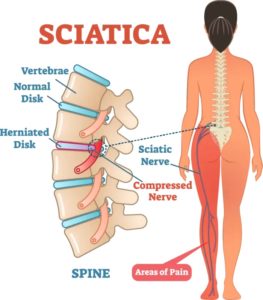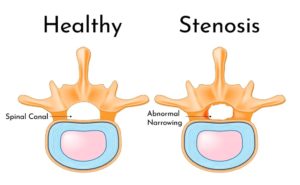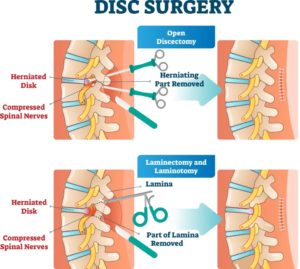Sciatica describes a radiating pain that can travel from your lower back down through your buttock and into your legs. The pain originates from pressure on the sciatic nerve specifically.
Did you know the sciatic nerve is the largest single nerve in the body? It has a diameter of slightly less than one inch and it provides motor and sensory feelings to the legs. It is also the most common cause of radiculopathy (pinched nerve) causing pain, numbness and tingling, and sometimes weakness in the legs. Most cases of sciatica pain are caused by a herniated disc and in many cases the pain improves in four to five weeks.

Where is the Sciatic Nerve Located?
The sciatic nerve stretches from your lower back all the way through your legs. The compression of the nerve happens in the spine usually from a herniated disc, or a bulging disc, that pinches the nerve causing pain. There are two sciatic nerves, one for the left side and one for the right side of your body.
What Does Sciatica Feel Like & What are Sciatica Symptoms?
Symptoms of Sciatica can be felt through the sciatic nerve, and since it runs from the lower back through the legs.
Sciatica pain may feel like a burning sensation or a shooting pain in the back or buttock and can reach through the thighs and feet.
 Numbness is also a symptom of sciatica that effects the leg it’s occurring in. Tingling and weakness may be another symptom when numbness occurs.
Numbness is also a symptom of sciatica that effects the leg it’s occurring in. Tingling and weakness may be another symptom when numbness occurs.
Usually the symptoms will only affect one leg, but in rare cases it can have an effect on both legs,
The symptoms can get worse when you’re sitting, moving to stand up, bending your spine, twisting your spine, laying down, and while coughing.
Causes of Sciatica
There are many medical conditions that can cause sciatica. It tends to develop over time, and the average age people start to be effected by it is 40. It’s common with people who bend forward, sideways, or raise the arms above shoulder level frequently. However, there are many causes of spinal pain which we’ll go over here.
A herniated lumbar disc is one of the most common causes of sciatica. This happens when a cushiony disc in your spine ruptures and the nucleus inside pushes outward onto the sciatic nerve.

Another cause of sciatica is lumbar spinal stenosis, which is a narrowing of the canals in your spine which can then compress the sciatic nerve. Lumbar degenerative disc disease contributes to lumbar spinal stenosis and herniated lumbar discs, so it can be a contributing factor.
Lumbar degenerative disc disease usually occurs naturally with age, but harsh treatment of the spine can speed the process up.
Spondylolisthesis is when a vertebra slips out of place, over another vertebra and will put pressure on the nerve. This can happen with age as well, but may occur in the case of an injury to the back or spine.
Muscle spasms can also cause sciatica, with inflammation of the lumbar and pelvic muscles. These occur after a strain or injury to the muscles, tendons or ligaments in the spine. Spasms caused by strain will settle down in about a week. If it doesn’t get better, or it happens regularly it can be a sign of an underlying condition such as degenerative disc disease, or spinal stenosis.
Some of the risk factors that can also contribute to sciatica are diabetes, being overweight, lack of exercise, wearing high heels, sleeping on a mattress that is too hard or soft, smoking, and driving for long periods of time regularly.
Sciatica Pregnancy Flare Ups
Pregnancy can cause back pain of all kinds, due to the extra weight in the front of the body, but sciatica is one of the more painful types of back pain during pregnancy. Sciatica comes about during pregnancy if the growing baby and expanding uterus puts pressure on the sciatic nerve, which will cause all the symptoms of sciatica like inflammation, irritation and pain. It will feel like shooting pain starting at your lower back and into your legs. These types of flare ups occur more often in the later stages of pregnancy as the baby gets bigger.
Sciatica Hip Pain
Another part of your body that can feel pain during a sciatica flare up are the hips. Though there can be many other causes of hip pain, sciatica can make it feel like the joints in your hips are causing aches and pains. Sciatica can effect the back, hips, buttocks and legs, so if any of these areas are in pain it might be sciatic nerve irritation. Hip pain due to sciatica might feel like a dull ache, and if it comes about with other sciatica associated symptoms then that’s likely the cause.
How is Sciatica Diagnosed?
Your doctor may check your muscle strength and reflexes, and check where your pain manifests for a preliminary sciatica check. If your pain is severe and persists over several weeks you may get imaging tests done to see the cause of your sciatica. An open MRI, X-Ray, CT Scan, or EMG can be used to detect if herniated discs or spinal stenosis is happening to cause your pain.
How long does Sciatica Last?
Acute sciatica is basically a new case of sciatica that can last one to two weeks, and often resolves itself in at most a few weekS. It’s common to feel numbness for a bit after the pain has gone away.
Chronic sciatica is chronic pain from the sciatic nerve that occurs regularly. You can seek pain management physicians to handle the chronic pain, or seek surgery for a permanent solution to sciatica depending on what the cause of it is, and how severe your symptoms are.
Sciatica Stretches, Back Stretches & Stretches for Lower Back Pain
Stretching certain areas can give you relief when it comes to sciatica, so just what are those stretches?
 Knee to chest stretch
Knee to chest stretch
This stretch involves laying on the ground flat on the floor, and raising your leg, bending the knee into your chest and holding for 30 seconds. You can do this with both legs and it will help decompress areas your sciatic nerve runs through to hopefully help relieve your pain.
Prone Press Up
This stretch involves positioning yourself stomach down on the floor, holding yourself steady with your forearms with your head off the ground. You can lay on pillows if laying flat is too painful. You’ll push the upper portion of your body upwards with your hands while keeping your legs flat on the floor. Your face should be facing forward and you should use slow and deliberate movements. Advance the press as far as you feel comfortable.
Yoga Cat Cow Stretches
This is a basic yoga pose where you start with your hands and knees on the floor, palms flat and your back flat. You will arch your back upward like a cat that’s afraid of something and look down. Then inverse this and curve your back the opposite direction while looking up to the ceiling.
Exercise for Lower Back Pain & Safe Sciatica Exercise
When you are exercising to deal with sciatica it’s important not to make the situation worse. You have to stay safe while attempting exercises, so if any motion feels more painful than before, definitely take a rest and perhaps try different exercises to deal with your lower back pain.
Standing Extension Exercise
For this exercise you will place your hands on your lower back, and push your pelvis forward. You are not trying to bend backward, but rather push yourself forward with your hands, and repeat. If the pain starts to feel worse in your legs, try a different exercise.

Side Planks & Regular Planks
Strengthening the abdominal and back muscles give more support for your back, so any sciatica flare ups may be less painful. Performing a plank will strengthen these muscles to help with your pain. Planking involves laying with your legs flat on your stomach and pushing your entire body up on your forearms so your body is straight hovering off the ground like a plank of wood. You hold this for 20-30 seconds or as long as you’d like. Side planks are a variation of the where you will be sideways, and pushing with one hand to make a 90 degree angle with your legs straight.
Aerobic exercises for sciatica
Walking can help exercise the lower back and is relatively low impact so walking at a brisk pace is a good exercise choice when it comes to aerobics. Try walking up to 3 miles a day for pain relief.
Sciatica Pain Relief & Treatment
Aside from stretching, and exercise as a method of sciatica therapy there are also medical options for treatment.
Pain management of sciatica can utilize anti-inflammatories (NSAIDs) like aspirin, or ibuprofen. You shouldn’t use this over a long period of time though, so if your pain is persistent you should look at more options. Your doctor may also prescribe stronger muscle relaxants as needed.
Sciatic Nerve Pain Relief & Inflammation Reduction
Steroid injections are the next course of action that is inserted directly into the irritated nerve, and provides immediately relief. This can improve mobility and function in your legs if these are symptoms that are bothering you. Though steroidal injections might not work on all types of sciatic pain. You may also need several injections to have long term pain relief of your sciatica.
Sciatica Pillow or Cushion
Using a pillow or cushion for sitting on when you suffer from sciatica is a useful tool to help alter posture, and align the body to promote proper circulation. Adding a simple cushion to your chair can give you some support while sitting if you have a job where you spend a large majority of the day sitting. Proper ergonomic posture is essential when dealing with issues of the spine.

Types of Sciatica Surgery to Relieve Pain
When sciatica is caused by a lumbar disc herniation you might be eligible for a discectomy. This surgery removes a small piece of your disc to reduce compression of your nerve, and this will give you pain relief.
Laminectomy removes part or all of the lamina part of your spine to make room for your spinal nerves. This is a surgery used to address lumbar spinal stenosis.
Foraminotomy enlarges one of your foramen areas of your spine, usually removing bone spurs that have grown to compress your nerve.
Laser surgery for Sciatica is a minimally invasive technique that uses a thin needle inserted directly into a herniated disc and shrinks the nucleus using heat. This will allow the herniation to subside and the pressure put on your nerve will be alleviated. The benefit of this over the other traditional surgeries is there are no incisions, and much quicker recovery times.


